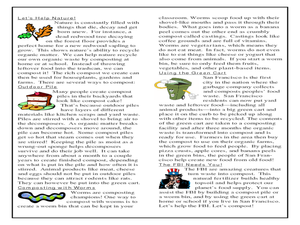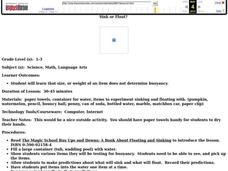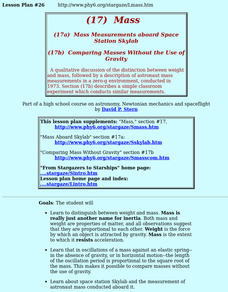Curated OER
MAKE IT FLY
Students utilize the process of scientific inquiry and technological design to explain thrust, weight, lift and drag in flight. They design an "airplane" to test the "mechanics" of flight. In addition, they brainstorm and sketch a design...
Curated OER
Mendeleev's Periodic Table
In this periodic table activity, students learn how Mendeleev organized elements by their atomic weight and grouped elements with the same properties. Students compare Mendeleev's periodic table with the modern periodic table. This...
Curated OER
Let's Build a Worm Bin
Students explore the process of decomposition. For this ecology and measurement lesson, students prepare a worm home to be used for vermicomposting. Students weigh a group of worms and the added food, recording this information on a data...
Curated OER
Observing and Questioning
Third graders investigate different types of soil. In this soil lesson, 3rd graders compare various soil samples. They work hands-on with their peers to find the differences and similarities.
Center for Learning in Action
Properties of Balls
Enhance your states of matter lessons with a hands-on science investigation that compares six different balls' color, texture, size, weight, ability to bounce, and buoyancy.
Cheetah Outreach
Life Cycles
How does a cheetah life cycle differ from a human life cycle? Kids graph weight gain for humans versus cheetahs and compare other life cycle events such as gestation and life span
It's About Time
Push or Pull - Adding Vectors
Demonstrate Newton's Second Law of Motion with an engaging lesson. Individuals explore the difference between forces in relation to a push or a pull, and they identify various forces that cause an object to move. They explore the concept...
University of Colorado
Modeling Sizes of Planets
The density of the huge planet of Saturn is 0.7 g/cm3, which means it could float in water! In the second part of 22, science pupils explore the size and order of the planets. They then calculate weight and/or gravity and density of...
Physics Classroom
Getting a Handle on Torque
Do your young physicists get a little unbalanced when it comes to talking about torque? Scholars examine the effects of weight and distance on a balanced system with a simple interactive from the Rotation and Balance series. The resource...
Physics Classroom
Torque-ing About Rotation
Let's talk torque! Science scholars evaluate experimental setups during an interactive from the Rotation and Balance series. Individuals calculate the torque of differently arranged weights to determine the effect they have on a balanced...
Discovery Science Center
Kindergarten Observing, Comparing and Contrasting
Although this is a science lesson, it can be adapted to help meet Common Core standards in math as well. Starting scientists describe physical properties of objects and explore three forms of water. To address the Common Core, they can...
Curated OER
All About Matter
Twenty-four questions about matter, the states of matter and the properties of matter make up this interactive online worksheet. Your class will determine the volume of water, the shape of water and the shapes of matter.
Teach Engineering
Machines and Tools (Part 2)
Which pulley system will give us a whale of a good time? Teams compare the theoretical and actual mechanical advantages of different pulley systems. They then form a recommendation for how to move a whale from an aquarium back to the ocean.
Community Resources for Science
Spring Mechanics
Scholars practice calculating spring constants before performing hands-on experiments. They compare data for parallel and series springs. Finally, they learn how spring mechanics find applications in biotechnology, such as prosthetic limbs.
Curated OER
Sink or Float?
Students predict and test different items to see if they sink or float. In this sink and float lesson plan, students predict whether an item is buoyant or not, and learn that size and weight do not matter when it comes to buoyancy.
University of Waikato
Investigating Soil Moisture Content
Class members analyze the water content in soil samples by drying out the samples and taking measurements every minute until all the moisture is gone. Scholars compare the initial weight to the dried weight to calculate the percentage of...
WindWise Education
How Does a Windmill Work?
Can my windmill pick up a weight? Given the same set of materials, groups design and build the most efficient windmill. On the first day, groups concentrate on getting a windmill to spin, while on the second day, they modify their...
Baylor College
Your Energy Needs (BMR)
How many Calories one needs on a daily basis is dependent on a number of factors including gender, height, and activity level. In the third of seven lessons about energy and food, young nutritionists calculate the number of Calories...
Nuffield Foundation
Investigating the Effect of Concentration of Blackcurrant Squash on Osmosis in Chipped Potatoes
Model and explore osmosis using squash and potatoes. Young scientists expose chunks of potatoes to different concentrations of a squash solution. They compare the weights of the chunks before and after exposure to the solution and use...
Howard Hughes Medical Institute
How the Body Uses Fat
Not all fat is bad—eating good fats actually helps with weight loss. Learn how the body uses fat through a 27-slide presentation that breaks down the path fat takes from entering to exiting the body. Understanding why fat is helpful and...
PBS
Going Green
Trash is where it's at! Using bags of garbage collected from the school, learners sort the contents into categories based on type of material and collect data on the results. The data may include weight, volume, and/or percent of the trash.
Curated OER
Mass
Students participate in a qualitative discussion of the distinction between weight and mass, followed by a description of astronaut mass measurements in a zero-g environment.
Curated OER
Can You Find the Difference?
Students create their own balance to determine a difference in the weight (and composition) of cents made in different years.
Curated OER
Liquids of Different Densities
Students compare the densities of different liquids. For this liquids lesson plan, students compare color, viscosity, weight, volume, and graph their findings.
Other popular searches
- Compare Weights in Pounds
- Math Compare Weights
- Sop Compare Weights
- Siop Compare Weights
- Math, Compare Weights

























